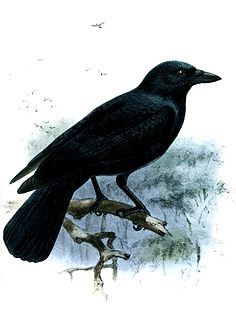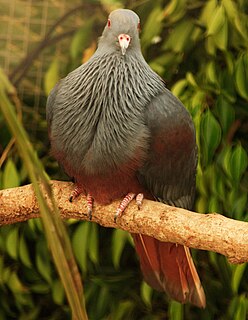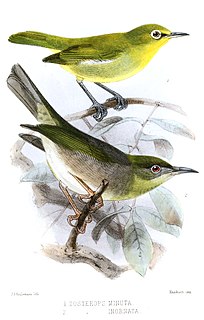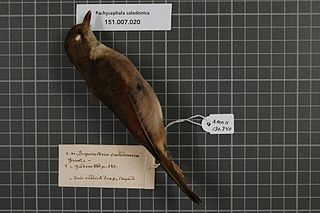 W
WThe New Caledonian crow is a medium-sized member of the family Corvidae, native to New Caledonia. The bird is often referred to as the 'qua-qua' due to its distinctive call. It eats a wide range of food, including many types of invertebrates, eggs, nestlings, small mammals, snails, nuts and seeds. The New Caledonian crow sometimes captures grubs in nooks or crevices by poking a twig at the grub to agitate it into biting the twig, which the crow then withdraws with the grub still attached. This method of feeding indicates the New Caledonian crow is capable of tool use. They are also able to make hooks. This species is also capable of solving a number of sophisticated cognitive tests which suggest that it is particularly intelligent. As a result of these findings, the New Caledonian crow has become a model species for scientists trying to understand the impact of tool use and manufacture on the evolution of intelligence.
 W
WThe New Caledonian cuckooshrike or New Caledonian cicadabird is a species of bird in the family Campephagidae. It is endemic to New Caledonia. Some taxonomists place this species in the genus Analisoma.
 W
WThe cloven-feathered dove is a species of bird in the family Columbidae. It is monotypic within the genus Drepanoptila, but this genus is possibly better merged into Ptilinopus. The cloven-feathered dove is endemic to New Caledonia where found in forest and Melaleuca savanna at altitudes up to 1,000 m (3,300 ft).
 W
WThe yellow-bellied flyrobin is a species of passerine bird in the Australasian robin family Petroicidae. It is the only species in the genus Cryptomicroeca. The yellow-bellied flyrobin is endemic to New Caledonia, where it occurs on the island of Grande Terre. It occupies a range of habitats, including dry lowlands, woodland, Pinus and Pandanus forest, and humid forest from sea level up to 1,525 m (5,003 ft).
 W
WThe goliath imperial pigeon, also known as the New Caledonian imperial pigeon and the notou, is a species of bird in the family Columbidae. It is endemic to New Caledonia. Its natural habitat is humid forests. The International Union for Conservation of Nature (IUCN) has assessed it as a near-threatened species.
 W
WThe white-bellied goshawk is a species of bird of prey in the family Accipitridae. It is endemic to New Caledonia. The species is also known as the New Caledonia goshawk or New Caledonia sparrowhawk.
 W
WThe barred honeyeater is a species of bird in the family Meliphagidae. It is endemic to New Caledonia.
 W
WThe crow honeyeater is a very large honeyeater endemic to humid forests in New Caledonia in the South Pacific.
 W
WThe kagu or cagou is a crested, long-legged, and bluish-grey bird endemic to the dense mountain forests of New Caledonia. It is the only surviving member of the genus Rhynochetos and the family Rhynochetidae, although a second species has been described from the fossil record. Measuring 55 cm (22 in) in length, it has pale grey plumage and bright red legs. Its 'nasal corns' are a unique feature not shared with any other bird. Almost flightless, it spends its time on or near the ground, where it hunts its invertebrate prey, and builds a nest of sticks on the forest floor. Both parents share incubation of a single egg, as well as rearing the chick. It has proven vulnerable to introduced predators and is threatened with extinction.
 W
WThe large Lifou white-eye is a species of bird in the family Zosteropidae. It is endemic to New Caledonia.
 W
WThe New Caledonian friarbird is a species of bird in the family Meliphagidae. It is endemic to New Caledonia.
 W
WThe New Caledonian lorikeet is a potentially extinct lorikeet endemic to the Melanesian island of New Caledonia.
 W
WThe New Caledonian myzomela is a species of bird in the honeyeater family Meliphagidae. The species is sometimes considered to be conspecific with the scarlet myzomela of Australia.
 W
WThe New Caledonian owlet-nightjar, also known as the enigmatic owlet-nightjar, is a large owlet-nightjar with vermiculated grey-brown and black plumage. It has a long, slightly rounded tail, short, rounded wings, and long, stout legs. Its voice is unknown, but other owlet-nightjar species make churring and whistling sounds. It is the second-largest known owlet-nightjar, much larger than the Australian owlet-nightjar.
 W
WThe New Caledonian rail is a large and drab flightless rail that is found on the island of New Caledonia in the Pacific. It is a dull brown above, with grey underparts, and has a yellowish, downward-curving bill. No one knows what it sounds like and it is not known whether it is nocturnal or crepuscular.
 W
WThe New Caledonia thicketbird or New Caledonia grassbird, is a bird species. Previously placed in the "Old World warbler" family Sylviidae, it does not seem to be a close relative of the typical warblers; probably it belongs in the grass warbler family Locustellidae. This species is endemic to New Caledonia.
 W
WThe Ouvea parakeet or Uvea parakeet, is a species of parrot in the genus Eunymphicus, in the family Psittaculidae. It is endemic to the island of Uvea in the Loyalty Islands, New Caledonia. The species was once considered conspecific with the horned parakeet of Grande Terre, but they have now been split into two species.
 W
WThe horned parakeet is a species of parrot in the genus Eunymphicus, in the family Psittaculidae. It is a medium-sized parrot endemic to New Caledonia. It is called "horned" because it has two black feathers that protrude from the head and have red tips.
 W
WThe New Caledonian parakeet or New Caledonian red-crowned parakeet, is a species of parrot in the family Psittaculidae. It is endemic to New Caledonia. The species was once considered to be conspecific with the red-fronted parakeet of New Zealand but is now considered a full species and is known to be the basal species in the genus Cyanoramphus, which had its origins in New Caledonia.
 W
WThe red-throated parrotfinch is a species of estrildid finch found in New Caledonia. It has an estimated global extent of occurrence of 20,000 to 50,000 km².
 W
WRhynochetos is a genus of ground-dwelling birds in the Kagu family. It contains two species, both endemic to New Caledonia, one of which is extinct.
 W
WThe small Lifou white-eye, also known as the sulphur white-eye, is a species of bird in the family Zosteropidae. It is endemic to the island of Lifou in New Caledonia.
 W
WThe striated starling is a species of starling in the family Sturnidae. It is endemic to New Caledonia.
 W
WThe New Caledonian whistler is a species of bird in the family Pachycephalidae. It is endemic to New Caledonia.
 W
WThe green-backed white-eye is a species of bird in the family Zosteropidae. It is also known as the New Caledonian white-eye. It is endemic to New Caledonia.